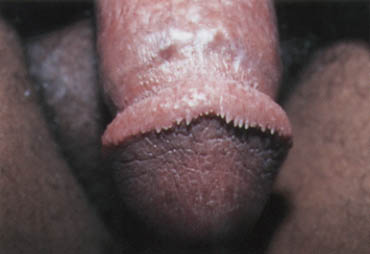
Am Fam Physician. 1998;57(7):1639-1640
A 24-year-old black man presented with painless small nodules on the penis (see the accompanying figure). He was referred for evaluation by his wife's physician because she had human papillomavirus infection, which had been identified through a Papanicolaou smear. The patient had no significant past medical history.

Question
Discussion
The answer is D: pearly penile papules. Pearly penile papules1,2 are relatively common benign tumors that occasionally occur in uncircumcised males such as this patient (note that in the photograph, the foreskin was retracted for better visualization). Histologically, these angiofibromas are seen as regular projections from the edge of the glans at the coronal margin. Studies3 have shown that these angiofibromas do not contain HPV DNA by polymerase chain reaction; therefore, they are not condyloma acuminata. Nor are they condyloma lata, which are the moist condylomas seen in secondary syphilis. Reassurance is usually the only treatment necessary, but occasionally patients may request that the papules be removed. Treatment may consist of cryosurgery4 or laser therapy.5 This patient was reassured and discharged to routine follow-up.